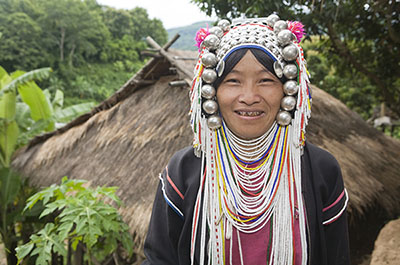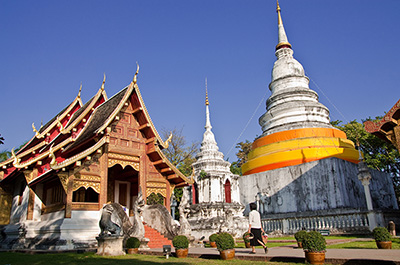
North Thailand
Regions & activities
North Thailand is an area very rich in culture and history, much of the area is mountainous and forested, there is a large number of national parks and it has a very different feel from the rest of Thailand.
The climate here is cooler than in the rest of the country, the architecture is different, even the food differs from Central and South Thailand.
Biggest city of the North
The biggest city of the North is Chiang Mai that hosts an enormous amount of Buddhist temples and historic places and is an excellent base to explore the North. The city has a population of 1,5 million people, however the atmosphere is relaxed and laid back.
North Thailand has many beautiful and interesting places worth a visit, like Chiang Rai, Mae Hong Son and the Golden Triangle where the Mekong river marks the border between Thailand, Laos and Burma and that was once famous for its opium production.
Border with Burma and Laos
The Northern region borders Burma and Laos. At a number of places it is now easy to cross the border from Thailand into Laos. Closest to Chiang Rai is Chiang Khong border crossing to Huay Xai in Laos. From here you can enjoy a slow boat ride on the Mekong river to the Laos city of Luang Prabang.
Another popular crossing is in the Northeastern province of Nong Khai, where you can enter Laos on foot crossing a bridge over the Mekong river. From here it is a short trip to Vientiane.
Trekking and other activities
North Thailand is very well suited for trekking. The beautiful mountain scenery, the cooler climate and the presence of a number of hill tribes like the Karen, Hmong, Shan, Lahu and Akha with their unique traditional clothing, language and culture make trekking a popular activity. Other activities in the North include white water rafting, rock climbing, elephant riding, temple tours and visiting national parks.
North Thailand climate
Since the area of North Thailand is mountainous, temperatures are a little lower than in the rest of the country, making it popular with Thai people. During January and February it can get cold at night, especially in the higher elevations. The rainy season lasts from May to October, but the amount of rainfall is considerably less than South Thailand. Many times it will rain for an hour during the end of the afternoon, clearing the heat. The dry season lasts from November to May. In March temperatures start to rise again and remain high until December. Average temperature in Chiang Mai is around 25 degrees Celsius, average rainfall is around 1,200 mm.
History of North Thailand
The history of North Thailand goes back thousands of years. One of the oldest remains of human civilizations in Thailand can be found in the village of Ban Chiang in Udon Thani province in the Northeast, which dates back to the Bronze Age, approximately 3,600 BC. There is a museum here where pottery and other items are on display, you can also visit part of the excavations. Ban Chiang is now a UNESCO World Heritage Site.
The ancient cities of Sukhothai, Kamphaeng Phet and Si Satchanalai were established in the 13th century. They are now UNESCO World Heritage Sites and offer many impressive structures on peaceful well kept grounds, that are often much less crowded than Ayutthaya and Angkor.
Farther North, the Lanna Kingdom which was established in 1259 by King Mengrai included an area in North Thailand from Kamphaeng Phet in the South to Luang Prabang in current Laos and parts of Burma to the North. In 1296, Chiang Mai became the capital city of Lanna. The Kingdom reached its peak of power in the 15th century during the reign of King Tilokaraja. In the 16th century Lanna began to lose power. Many wars were fought out with the Burmese and Laos and eventually Lanna became occupied by the Burmese.
How to get to North Thailand
Buy tickets online
Tickets for flights, bus, train or taxi from Bangkok or another city can be bought online at the 12Go website.
Air
The quickest and most comfortable way to get to the North is by airplane. Chiang Mai receives multiple flights daily from Bangkok. Smaller airports with less regular flights include Sukhothai, Lampang, Phrae, Lampang and Mae Hong Son. Availability of flights to these places vary per season.
Train
A cheaper but slow alternative to flying is to catch a train. Multiple trains depart Bangkok’s Hua Lamphong station for Chiang Mai every day, both sleeper trains and day trains. If you want to see beautiful scenery during your way to the North, the train might be a good choice. This journey will generally take 12 hours or more.
Check details and how to get tickets at Travel Thailand by train.
Bus
A little quicker than the train, the bus service from Bangkok to Chiang Mai takes around 10 hours and is popular with Thai people. Buses leave from Mochit station in North Bangkok. During Thai public holidays like Songkran and Loy Krathong the bus service will be extremely busy, so advanced booking is recommended.





